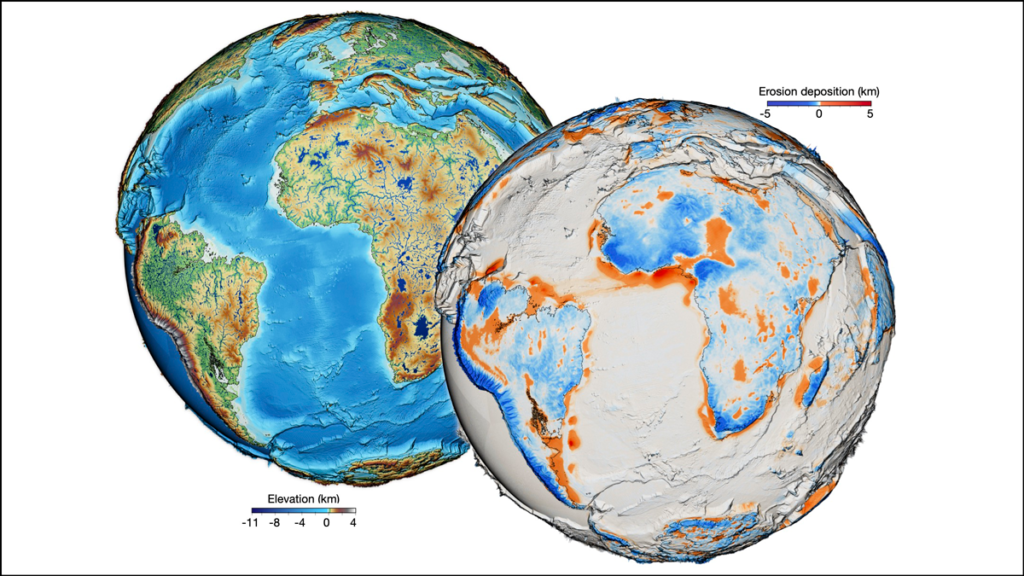
Earth’s complex and varied surface is shaped by myriad natural processes—from deep-seated faults thrusting mountains skyward to rivers carving valleys and carrying sediment to the ocean. To develop a fuller picture of how our planet’s outer layer has evolved, geoscientists piece together the interactions among these processes with geological models.
But like a puzzle with missing pieces, existing models have given only a patchy understanding of Earth’s past 100 million years.
Now, researchers have developed a high-resolution, continuous model of Earth’s geologically recent evolution. The advanced model can inform us about our planet’s long-term climate and biological changes, how today’s landscapes were formed, and how millions of tons of sediment were dumped into the ocean.
“This is a significant technical advance, as it provides for the first time a global perspective on the relationships between sediment transfer and Earth’s physiographic changes,” said Tristan Salles, a senior lecturer in geosciences at the University of Sydney in Australia and lead author of a new paper introducing the model published in Science.
Reading the goSPL
Computer-based methods for reconstructing landscape evolution have been used since the 1990s. Geomodeling software also has been a familiar tool for interpreting geological data, building 3D models of Earth’s surface, and simulating the evolution of landscapes over time.
The team collated these technologies with a model using a recently released software tool some of the coauthors developed called goSPL (global scalable paleo landscape evolution). The model evaluates the evolution of Earth’s surface globally, considering interactions with tectonics and activities and processes in the mantle, hydrosphere, and even atmosphere.
Some of the coauthors built goSPL using data based on the physics of surface processes, sediment accumulation maps, tectonic movement, and climate trends of the past. The research team then improved the accuracy of the model’s predictions by calibrating it with present-day observations from rainfall and water flows.
The simulations yielded high-resolution maps showing the physical landscapes and water drainage networks of Earth on a global scale for the past 100 million years. The simulation boasts a spatial resolution of 10 kilometers, broken into million-year frames.
“We combined various information and observations from present-day rivers’ sediment and water fluxes, drainage basin areas, seismic surveys as well as long-term local and global erosion trends,” Salles said.
Monumental Takeaways
The simulation shows mountains rising and falling, continents shifting, and sediment moving from land to ocean. By better visualizing sediment flow, for instance, it clarifies upstream dynamics as well as the development of basins and other landscapes downstream. In one example, the simulation shows how river channels and tributaries in South America’s Paraná Basin have changed position under the influence of tectonics and climate.
“The Salles et al. study represents an exciting achievement,” said geomodeler Charles Shobe at West Virginia University, who noted three major advances in the study. “Firstly, they successfully work at the global scale, whereas we typically run these sorts of models at the watershed to mountain range scale,” he explained. “Secondly, their approach incorporates detailed tectonic and climatic reconstructions that allow for inputs like tectonic plate motion and precipitation.… Thirdly, they successfully ‘nudge’ their model to make sure it stays true to reconstructions of past topography,” Shobe said.
If the past is the key to the future, this one model could help scientists foresee phenomena as varied as how oceans will evolve in response to climate change, the impact of tectonics, and how sediment transport will regulate our planet’s carbon cycle.
This article originally appeared in Eos Magazine.


